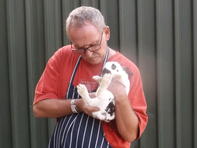
Bucks (Male Rabbits)
The bucks in your herd are the most valuable animals you have and should be of the highest possible quality. A stud buck can cover up to 10 does per month and therefore his genetics are spread through many more babies than the progeny of any one doe.
In one month he can provide the genetics for an average of 60 - 80 youngsters, depending on the birth average and weaning average achieved. The stud buck must be easy to handle and ideally in a very accessible hutch.
The door to his hutch should be big enough so it is easy to get the doe in and out the hutch. Bucks should always be housed alone.
Two bucks will fight very badly and castrate each other very easily. As bucks tend to spray urine on their neighbours; a solid partition between the cages can be very handy.

Does (Female Rabbits)
Always take the doe to the buck. Does are very territorial and will resent a buck in her space and will attack him if he intrudes. When selecting a doe for breeding, check that she has a minimum of eight nipples for a large breed and six for the mini breeds. Before putting the doe in the buck’s hutch, check to see that she is on heat.
Take her out of her cage and turn her upside down in your arms. With one hand, gently pull her tail back and press gently on her vulva. If her genitals are small and pale pink, place her back in her cage, stroke her several times from head to tail to stimulate her and test again the following day. A doe ready for the buck is usually swollen and dark purple in colour.
Place the doe in the buck's hutch and watch. He will approach and the mating is usually very quick. He will mount her and she will lift her hind quarter off the cage floor. He will pump briefly and ejaculate by rolling into a tight ball over her back and fall off, either backwards or to the side. This seldom takes more than a minute or two.
Wait for a second mating, remove the doe and take her back to her cage. On the doe’s hutch card (see record keeping) write down the date of mating, the name or number of the buck used and made a note in a diary. Then, 27 days later give her a nest box, filled with straw or dry grass.
The babies will arrive on day 30 or 31 after mating and are most often born in the early hours of the morning. The mother rabbit will make a nest in her nest box using the materials provided and will also pluck hair from her chest and tummy to make a bed for her litter. It is very unusual for a doe to give birth with people around.
The doe gives birth very quickly and will immediately lick the babies clean and move any dead babies to the side. When they are dry she will feed them. Does only feed twice a day; at sunrise and sunset. It is very seldom that the breeder will see the doe feeding. She likes her privacy. You will see she has had her babies by a pile of fluff wriggling in the box.
Distract the doe with a treat (a handful of grass, a piece of carrot etc.) and carefully open the nest, count the babies and check that there are no dead one or leftover placentas. Remove any wet bedding, cover the babies up again and leave alone until the next morning.
